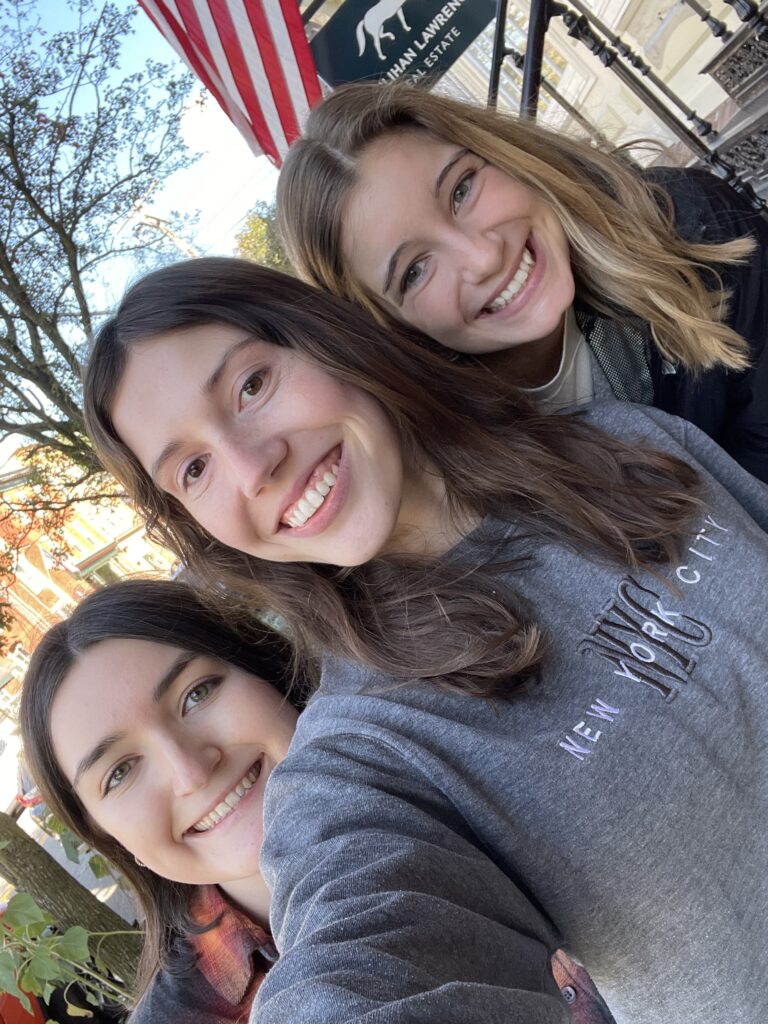By Jasmine Jones
There is a specific sound: a low hum, a soft ding, an echo of a ring that I now associate with my two best friends.
It is not the sound of metal spoons colliding in my dishwasher in my usually-quiet studio apartment; it is the sound of Facebook Messenger. A notification.
When I hear that sound, a sweet little capsule of my friend Hannah’s or Emily’s voice is delivered to my phone. I record my own voice and send a memo back to them in our group chat labeled “Eldest Daughters,” since we’re all the oldest siblings in our families.
Hannah, Emily and I met in college. Hannah was my suitemate, and I met Emily through a campus ministry. I knew them separately for a while; then, they became friends with each other through their jobs as resident assistants. Now, we’re a serendipitous trio of friends.
In college, it was easy to keep in touch, because we all lived together on the same parcel of hilly land, getting coffee at the same Starbucks and walking to the same buildings every day for class. Now, we live in different cities: St. Louis, New York City and Cape Girardeau.
Physical distance only adds to the many obstacles already present in adult friendships. As a child, I simply knocked on my neighbor friend’s door whenever I wanted and jumped on her trampoline if she wasn’t home. But as an adult, friendships seem to require a calendar, strings of text messages, multiple phone calls, a buffer of two or three days’ time, a confirmation email: “Does 6 p.m. on Thursday still work for you?”
Our voice memos are a reaction and response to the stiff “adult” approach to friendship. This form of communication is personal and feels like an endless phone call, one you don’t have to pencil into your Thursday evening. We can talk anytime, listen anytime. Through this daily connection, we are able to share what is happening in our lives while it is happening.
We call the voice memos our friendship podcasts — little one- to 15-minute recordings detailing the happenings in our lives. Our pains and sorrows and joys and triumphs.
We talk about love and break-ups, work stresses and new adult things we’re still learning, like taxes and insurance. We monologue and discuss our observations of the world. How everything is changing, yet stagnant. How we are a part of it.
We talk about Taylor Swift, focaccia bread, marathons, public transportation, cars, family members, Missouri, New York, school districts, art, faith and college. We talk about everything, because we are experiencing everything. Instead of feeling those overlapping, tumultuous, ever-changing waves of human emotion alone, we open up, lay out our most vulnerable selves, listen to each other and swim together in that intimidating ocean we call life. We are friends, after all. And that is friendship.
Of course, it’s still nice to talk on the phone, and visiting in-person is ideal, but the voice memos offer a deep, daily connection. When we do physically meet in the world, there is no “catching up,” because we’re already caught up. We’re ingrained in each other’s lives, knowing the smallest details — what we did on our Saturday mornings, the books we’re reading, the tough conversations we had with family members or other friends. We exchange lots of “here for you”s and heart emojis in Facebook messenger, and all of them are intentional gestures, words with hugs behind them.
We celebrate together, too. Emily got into graduate school recently and sent a video to the group chat of her pressing the button to officially register, thinking we could witness this momentous occasion with her, even if digitally, but when she clicked the button, a box popped up. She said, “Oh, there’s a fee,” and then burst out laughing. We watched the video and laughed alongside her.
Hannah, Emily and I may not be physical neighbors, but we’re still living life together. We bask in the little delights, bond over the struggles. We scream into our phones: out of joy, out of frustration. We all deserve people in our lives whom we can scream to, whom we can find comfort in and be our truest selves, the selves that shift day-by-day as our lives shift day-by-day. Through the work and intention of daily communication — whether the mode of communication is voice memos, phone calls, Snapchats or one of the countless other options available — we can find this unforeseen depth in our friendships. We don’t have to do it all alone.
We swim in this ocean together, paddling with our own feet, but holding each other’s hands as the waves crash against the sand, reinventing the land behind us, suspending us in the present.
Keep in touch.
If your bestie lives far away, don’t fret. There are still many ways to forge deeper connections, have regular conversations and laugh with the people you love.
Here are some creative methods of keeping in touch — and having fun — with your long-distance friend.
1. Send snail mail.
It’s always a good idea to remind your friend — and yourself — how cool and amazing your handwriting is. Take advantage of the miracle we call the Post Office and send an occasion-less greeting card. Once they get it, make your friend put the card on their fridge. Then, make them mail a photo of their fridge to you as proof and put that photo on your fridge. Repeat.
2. Make personalized playlists.
There is a song out there for almost any situation. If your friend is about to embark on a study abroad adventure, send them a playlist with wanderlusty songs by Beirut and Fleet Foxes. If your friend is going through a breakup, send them a playlist featuring Taylor Swift’s “tolerate it” and “All Too Well.” (But ask for their consent to cry first. Because they will cry many tears.)
3. Share food pics.
If you eat, cook or bake something delicious or cool or complicated, snap a photo, send it to your friend. Or, you can send a photo of your lunch break peanut butter sandwich. It doesn’t matter. That food is remaking your cells. You deserve to share it with someone you love.
4. Form a book club.
Choose a book to read together. Then, actually read it. Schedule a Zoom call or FaceTime to discuss the deets when finished. If you and your bestie are really annoying and extra, write and exchange essays about the book. Be sure to cite your sources.
5. Explore new hobbies together.
Crochet stuffed animals. Bake fancy cakes. Hunt for morels. Create your own bouquets. Become poets together, then text each other emoji poems — poems made entirely of emojis — and have your friend attempt to translate. There are so many fun activities in our world. Experience them together — even if you’re physically apart.




